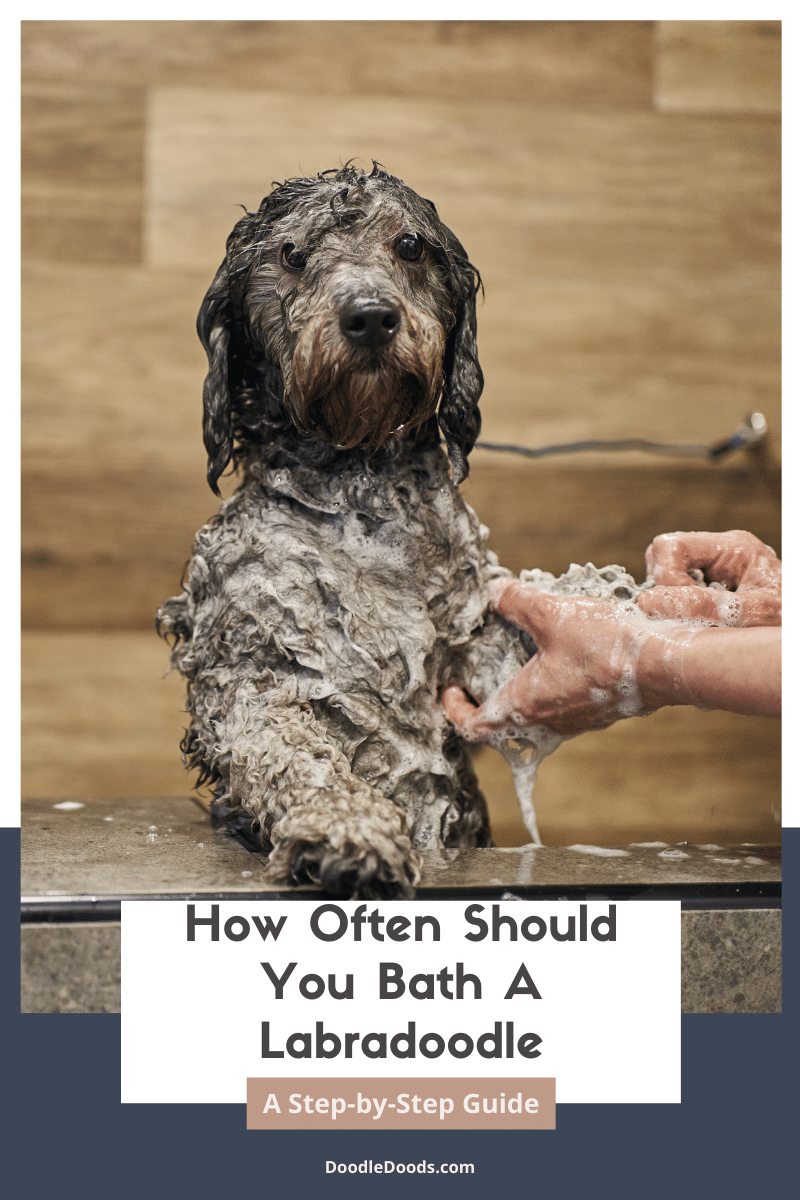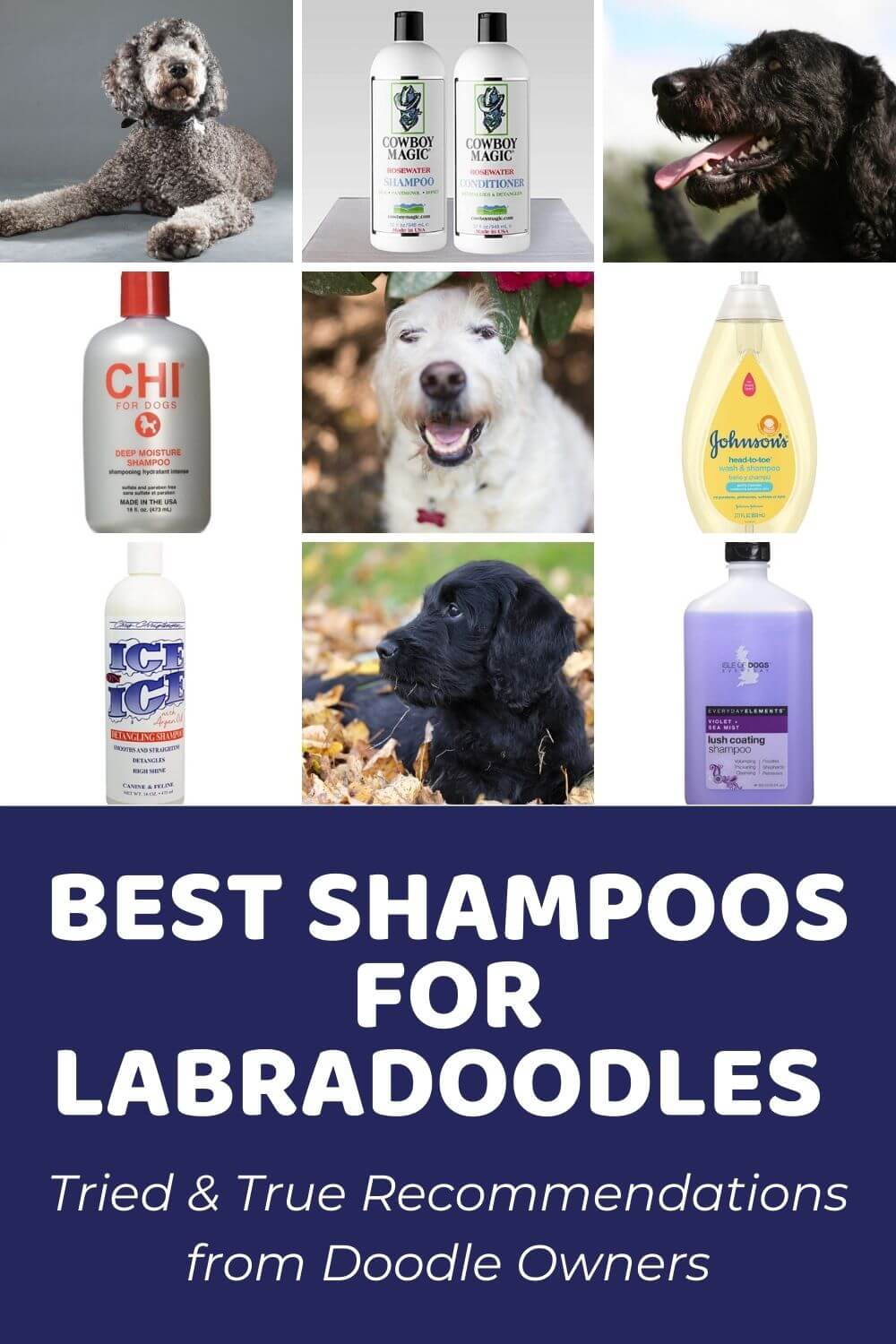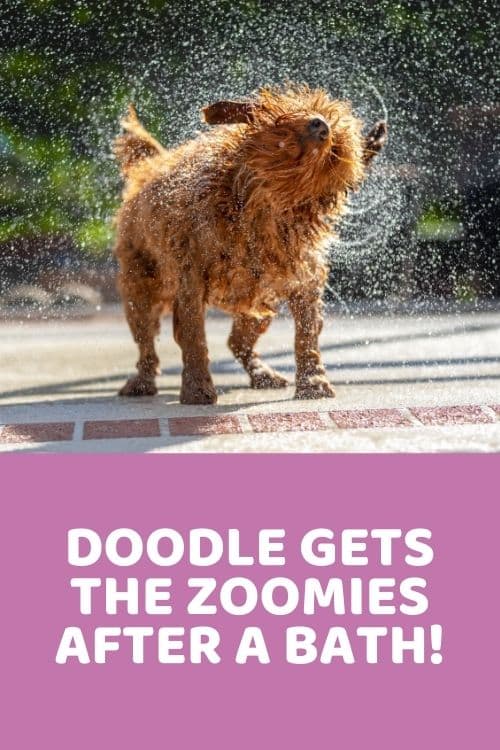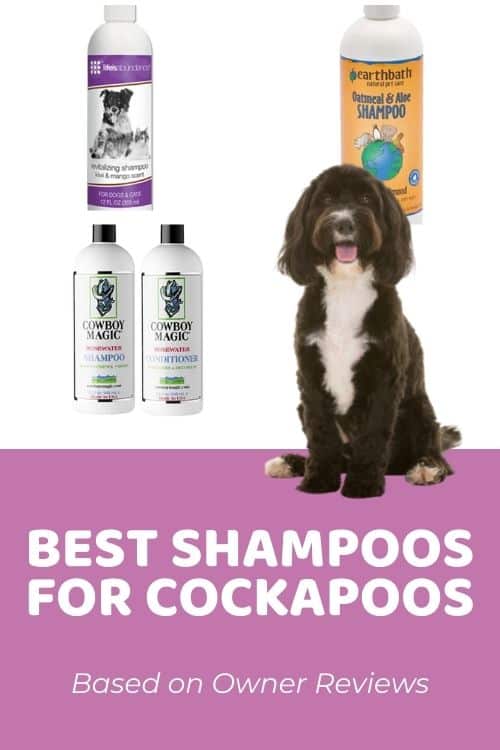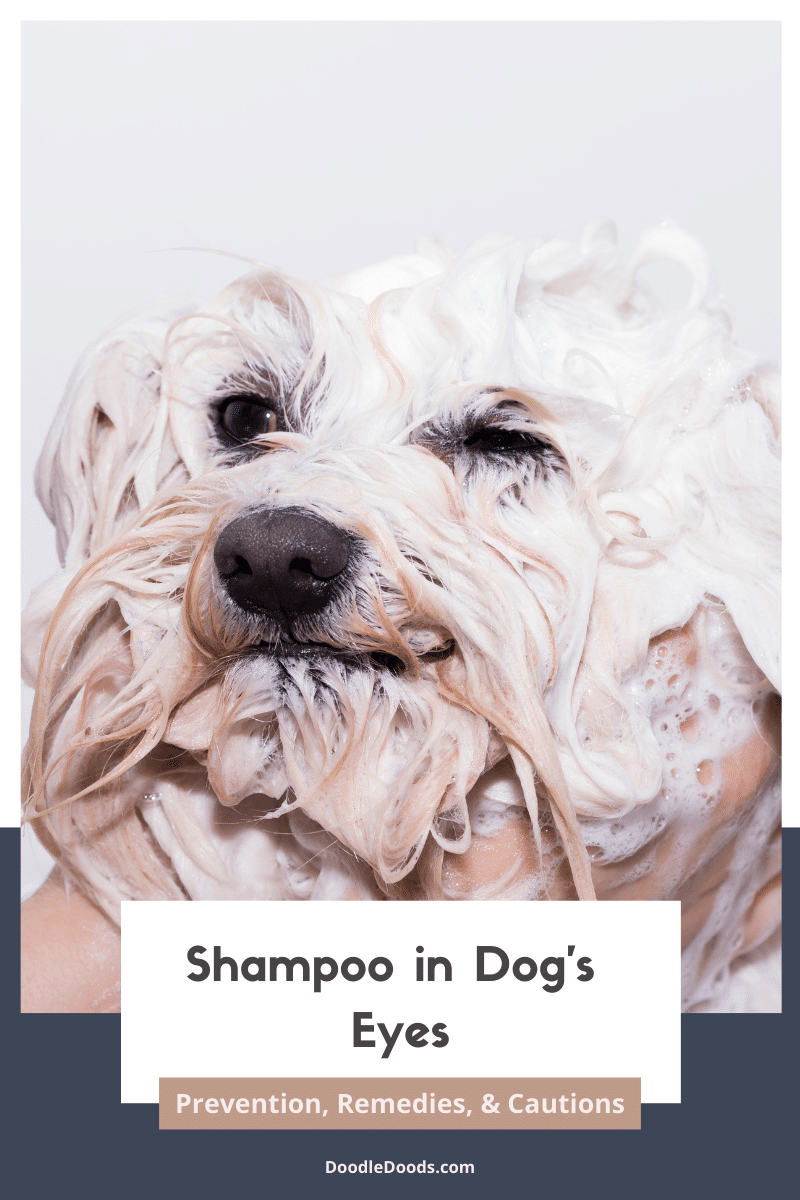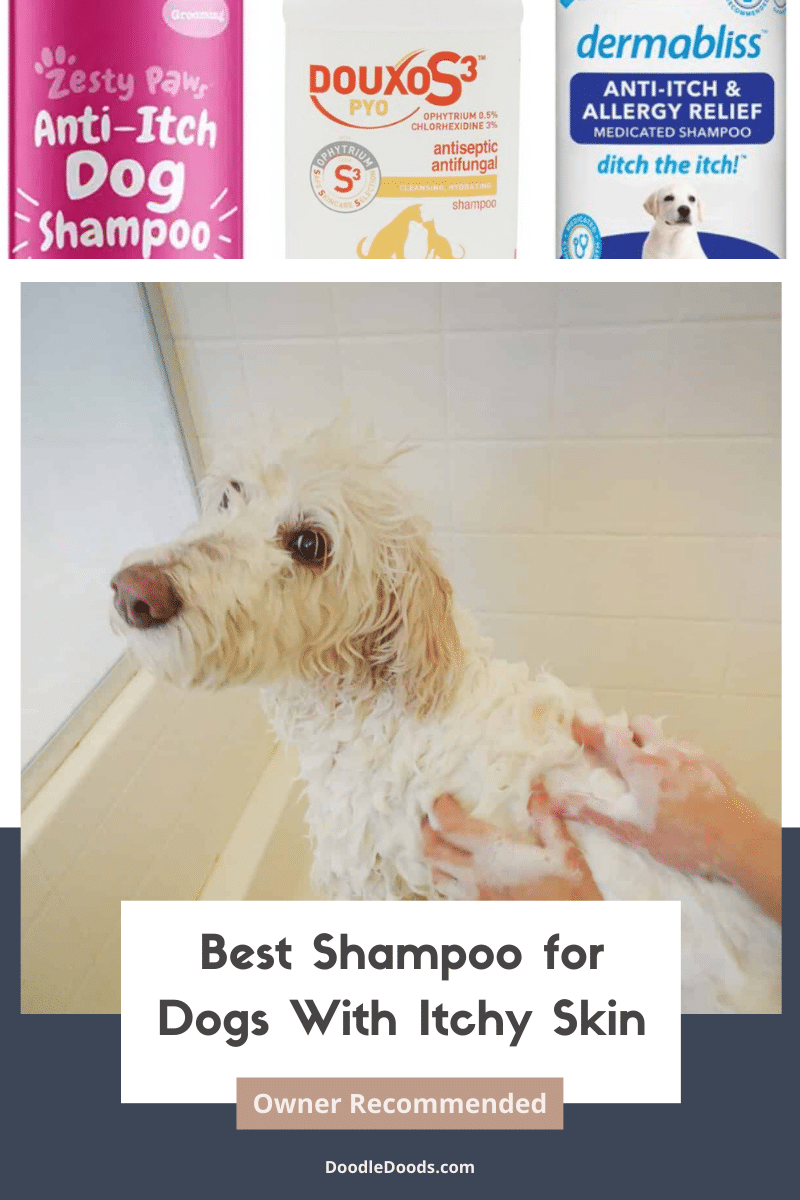Congratulations! You’ve got one of the cutest Doods on the block. But as we all know, Labradoodles also need to be properly groomed to maintain their gorgeous looks and good health. Since we talk about all things Doodles, we often get asked this common question – how often should I bathe my Labradoodle? That’s exactly what we’re going to discuss in this guide, so keep on reading to learn more.
Table of Contents
- How Often Should I Bathe My Labradoodle: Intro
- Why Proper Grooming And Bathing Is Important For Your Labradoodle
- Labradoodle Coat Types And Their Bathing Requirements
- How Often Should I Bathe My Labradoodle?
- What Is The Recommended Age To Start Bathing My Labradoodle?
- Step-By-Step Guide On How To Bathe Your Labradoodle
- Best Shampoo For Labradoodles
- Products To Use For Bathing Your Labradoodle: The Complete Grooming And Bathing Kit
- Tips For Grooming Your Labradoodle At Home
- How Should I Get My Labradoodle Used To Bathing?
- Is It Safe To Use A Hairdryer To Dry Labradoodles’ Coat?
- How Often Should I Bathe My Labradoodle: FAQs
- How Often Should I Bathe My Labradoodle: Final Thoughts
How Often Should I Bathe My Labradoodle: Intro
The adorable Labrador Retriever-Poodle mix has been one of the most well-known and loved Doodles for a few decades now. They’re sweet-natured, fun-loving, and overall just wonderful bundles of joys to be around. Not to mention, they’ve got the looks and the smarts. The perfect combination!
You probably know all too well about the Labradoodle’s low-shedding, even hypoallergenic coat. But although they’re low-maintenance in terms of their shedding potential, it doesn’t necessarily mean that they’re low-maintenance when it comes to their grooming requirements.
One of the most important steps in your Labradoodle’s grooming routine is bathing. But how often should you bathe a Labradoodle, anyway? And how to do it? Especially if your pup isn’t exactly keen on getting into the shower whenever they get a bit smelly or dirty…
Get ready, because we’ve gathered here all the information you need to know about how often to bathe a Labradoodle, as well as our step-by-step guide on how to do it properly. By the way, we also have some awesome tips and tricks up our sleeve that’ll help you make this process an absolute breeze.
Why Proper Grooming And Bathing Is Important For Your Labradoodle
Let’s talk about one of the best ways to show your Labradoodle some serious love: grooming and bathing. Not only does it help them look and smell great, but it’s also essential to keeping their coat and skin healthy.
First of all, regular grooming and brushing is crucial to prevent matting and tangling, which can quickly turn into a matted mess if left unattended. And believe us, no one wants to deal with a miserably tangled pup! Or worse, have all of your Labradoodle’s beautiful hair shaved off… Not only can matting and tangles lead to discomfort and skin irritations, but it can also make bath-time a more laborious undertaking than it needs to be.
Speaking of bathtime, regular bathing helps to remove dirt, debris, and any lingering odors that your pup may have picked up on their outdoor romps. With a little TLC and some time spent in the tub, your Labradoodle will smell fresh, which is obviously nice for both of you. Just make sure to use a dog shampoo, as human shampoos can strip their skin of precious oils and cause unwanted skin irritations.
But that’s not all! Did you know that you can use special shampoos for targeted care? That’s right – whether your Labradoodle has sensitive skin, is prone to shedding, or needs some extra moisturization, there’s a dog shampoo out there that can cater to their unique needs.
So there you have it – grooming and bathing may seem like just another chore, but it’s actually a crucial aspect of keeping your Labradoodle healthy and happy. So grab that brush, fill up the tub, and show your pup some grooming love today!
Labradoodle Coat Types And Their Bathing Requirements
When it comes to your Labradoodle’s bathing schedule, their coat type and hair length can greatly determine how often you should bathe them. Let’s take a closer look:
Consider Your Labradoodle’s Coat Type
Firstly, it’s important you know exactly which coat type your Labradoodle has. Labradoodles come in either curly, wavy, or straight coats, depending on which genetics they inherit from each of their purebred parents.
The highly coveted curly coat may be the most hypoallergenic of them all, but it’s also the most high-maintenance. Curly coats tend to trap in dirt, debris, and loose dog hair, which can quickly lead to stubborn knots and tangles inside the fur. These pups need more frequent brushing sessions than others, but they may also get dirty quite fast if you’re not properly taking care of their beautiful curls.
Then we have the wavy combination coat, that may shed some hair, depending on whether they have an undercoat or not. The hair texture is usually silky and it’s rather easy to groom. It won’t trap in as much dirt and debris as the curly coat, but regular brushing and bathing is still vital for these Doods.
And finally, there’s the straight coat, which is more of a nod to the Labradoodle’s Labrador Retriever heritage. These pups usually come with a double coat, which means that some shedding may be present. Fortunately, you can keep this at a minimum by regularly brushing your Labradoodle. And if necessary, you can also opt for a special dog shampoo that’s designed to help minimize shedding.
Different Lengths Require Different Approaches
In addition to your Labradoodle’s coat type, another thing to factor in is their coat length. It goes without saying that Labradoodles really shine with their long and fluffy coats, giving them that signature Doodle look. However, long hair also requires more brushing and bathing. This helps prevent matting, but also get rid of any build-up dirt, dander, loose dog hair, and debris from the coat.
On the other hand, shorter hair is usually easier to manage and maintain. Short hair won’t get as easily tangled and it usually stays cleaner for longer, too. So, if you’re not exactly keen on constantly grooming your Dood’s fur, then a shorter hairdo might be a better option for your pup!
How Often Should I Bathe My Labradoodle?
Now onto the big question that we’ve teased since the beginning of this article – how often should I bathe my Labradoodle?
Unfortunately, there’s no one size fits all approach to this topic. How often to bathe a Labradoodle depends on a variety of factors, including their hair length, coat type, but also how active your pup is, and if they’ve got any skin conditions that require special care.
If you’re wondering how often you should bathe your Labradoodle, then the usual recommendation is about once a month or before every haircut, which is about every 6 to 8 weeks. However, if you’ve got a very active dog or they trigger your allergies, then some might even recommend weekly bathing. And for other pups, washing them every two months is perfectly enough!
It all boils down to your pup’s unique needs and your own, as well. If you’re not fond of smelly cuddles, you might want to wash them between their grooming salon visits. But if your Labradoodle struggles with skin dryness or irritations, then bathing them too often could lead to more problems down the line. And it should go without saying that if your Labradoodle is visibly dirty and smells, it’s time for an urgent wash.
What Is The Recommended Age To Start Bathing My Labradoodle?
We recommend you start bathing your Labradoodle as soon as possible. If you introduce your new puppy to bathing from an early age, they’ll be much more likely to enjoy it once they’re all grown up.
In fact, many reputable Labradoodle breeders already start basic grooming, such as brushing, nail trimming, and bathing even before adoption. Just make sure you continue with this at home so that your pooch can get used to it.
Step-By-Step Guide On How To Bathe Your Labradoodle
Now that we’ve answered your question “how often should I bathe my Labradoodle?” it’s time we get into the details. Here’s a step-by-step guide on how to bathe your Labradoodle so that they step out of the shower squeaky clean and smelling fresh.
Remove All The Loose Dirt Using A Brush
Before you get your Labradoodle into the tub, it’s vital that you thoroughly brush their coat to remove any knots and tangles, loose dog hair, dirt, and debris. For this step, we recommend you also get a dog detangler spray, which will help you get the job done much faster.
The next logical question would be – how to brush a Labradoodle? Although there’s nothing difficult about it, learning the correct technique will help you get the job done much faster and with minimal fuss.
First, you want to run your fingers through all areas of the fur. If you find any knots, first work on each of them individually with a sturdy metal comb. Once that’s done, you can start brushing your Labradoodle. PS! Make sure you never pull on the hair!
Start from the feet and paws, moving your way up towards the belly and neck, and finish with the back. Be sure to start brushing from the tip of the hair and then moving up towards the root to prevent any tangles getting worse. One of our favorite methods for Doodles is line brushing – say goodbye to any knots and tangles!
Here’s a helpful illustration for brushing your Labradoodle:
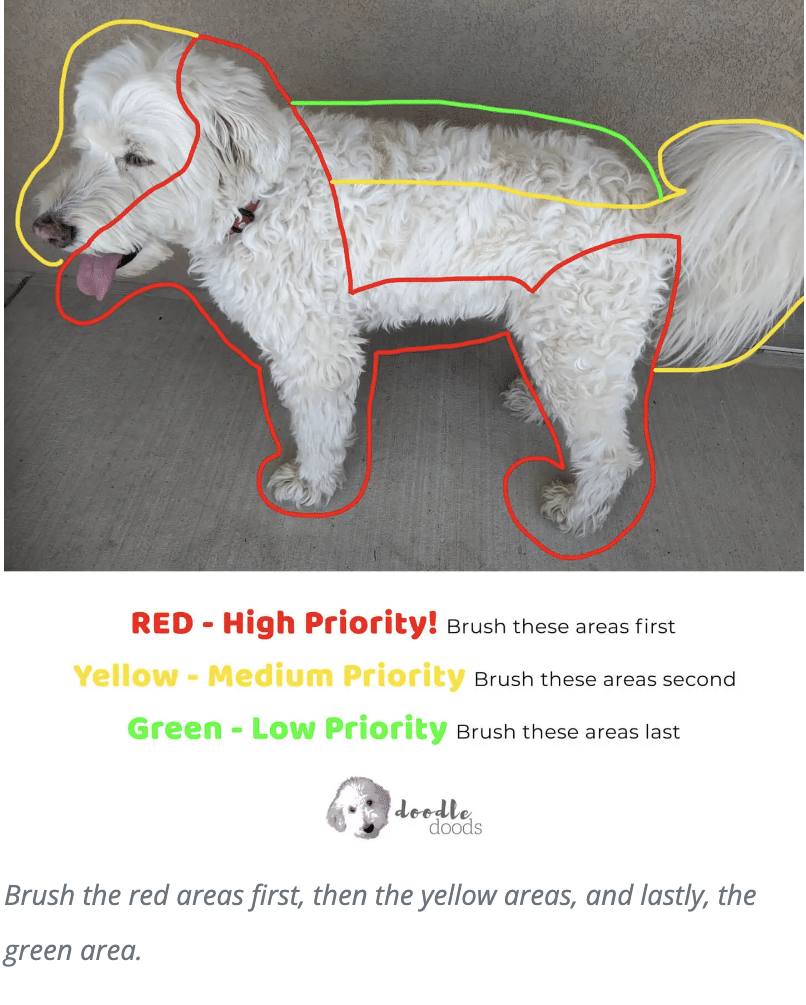
Make Your Labradoodle Comfortable With Bathing
Before you go all in with the scary showerhead and dog shampoo, you want to make sure that your pooch feels comfortable. Start out by putting a little bit of warm water in the bottom of your bathtub so that your pup can just stand in it.
Once they’re okay just standing there, you can slowly introduce them to the showerhead. You might even want to let them sniff and inspect it first. If your Dood seems all good, you can turn on the showerhead while petting them at the same time. Having a few tasty treats at hand can also be helpful here! You want to ensure your pooch that everything’s fine and they’re safe with you by their side.
Cover Sensitive Areas Like Ears, Eyes, And Nose
A helpful tip when bathing your Labradoodle is to make sure that no water gets into their eyes, nose, or ears. You can gently cover them with your free hand or if you’ve got a really well-behaved and calm Labradoodle, just rinse other body parts without getting their delicate eyes and nose wet.
For the ears, we recommend putting cotton balls right at the opening of the ear canals. This will prevent any water from getting into the ears.
Check The Water Temperature And Completely Wet The Fur
Now that you’re all set, you can start rinsing your Labradoodle’s coat. Before you lather up the shampoo, completely wet your dog’s fur to get rid of any dust and debris in their coat. Make sure that the water temperature is just right – not too hot and not too cold. By thoroughly rinsing the coat beforehand, the shampoo can also lather up nice and easy.
Gently Apply The Shampoo To Your Labradoodle’s Coat
Once you’ve rinsed the coat with no products and the fur is thoroughly wet, you can jump in with your dog shampoo.
Apply a generous amount of your chosen dog shampoo and lather it up all over the coat. We recommend you start with the body and don’t wash the head and face just yet. Make sure you properly massage the shampoo into the fur so that you can get all areas clean. Also, be mindful of areas like the armpits and groin, as some people tend to overlook them.
This is also a great opportunity for you to check for any lumps and bumps under the skin. If you notice any, it’s time for a vet visit.
Rinse The Shampoo
Now that you’ve shampooed all of your Labraododle’s body, it’s time to rinse it out. Again, make sure you use warm water and thoroughly rinse off all areas of the fur, especially armpits and groin, where the suds tend to collect. You’ll want to avoid leaving any residue products behind, as these can irritate your dog’s skin.
Shampoo The Head & Face
Next up, you’ll move onto the head and face. Now you’ll have to be extra mindful so as to not get any water inside the eyes, ears, and nose. For obvious reasons, we recommend a tearless dog shampoo for the facial area.
Again, you’ll want to properly lather up the shampoo and massage your pup’s face to get a good clean. You might want to pay some extra attention to areas that tend to get dirty, such as the muzzle and beard. And if your pup has tear stains, don’t forget to focus on these, too.
Then, you’ll want to rinse it all off while being very careful to not get any water or shampoo directly into the eyes or nose. Since the face can be a bit tricky, it might take some time to thoroughly rinse off all that shampoo.
Detangle Your Labradoodle’s Hair After You Apply A Conditioner
Now that your Dood is all cleaned up, you’re ready to apply a specially formulated dog conditioner, which does exactly what it says – conditions the coat and skin.
Apply a decent amount of conditioner with your hands all over the fur. Although conditioning the head and face is optional, it is recommended for curly-coated Labradoodles.
Once you’ve massaged the conditioner into the fur, we recommend you gently comb through the fur with your stainless steel comb. This way, the product gets into all areas of the fur, but also prevents tangling.
Thoroughly Rinse Off The Conditioner
And now we’re back at the rinsing step! Conditioners may sometimes be slightly harder to rinse out, so make sure you’re extra cautious here. Again, pay extra attention to those hard-to-reach areas that we tend to overlook.
Dry Your Dog With A Towel And Use A Hairdryer
Well done! The biggest work is now done and you’re ready to dry your Dood. Before you jump in with a towel, let your pooch shake all that excess water off themself. We hope you’re not wearing your fanciest clothes, because you’ll very likely get wet. Then, you can gently squeeze out any excess water from areas with longer hair with your hands.
Then, take your towel and start gently, yet firmly patting your Labradoodle dry all over. You might even need a couple of backup towels, since they’re going to soak up a lot of water. As you won’t get all the fur completely dry with a towel, you’ll also need to blow dry their hair.
Before you start blow drying your Labradoodle, make sure that they’re comfortable with the noise it makes. You should start with the lowest power and temperature settings. If necessary, you can gradually increase the settings, but the temperature should never get too hot.
Also, keep in mind that some pups can get scared of noisy blow dryers. Before you start blow drying, introduce them to it when it’s turned off so that they can inspect it.
Brush Your Labradoodle Once More
Tangles are bound to form after bathing your Dood, so make sure you give them another thorough brush once they’re all dry. If you can’t be bothered with this step, be prepared to deal with stubborn knots soon after.
You can also use a leave-in dog conditioner or a dog detangler spray and brush it through the fur to keep the coat tangle-free and luscious for longer.
Clean Your Labradoodle’s Ears
As you’re done drying and brushing your Dood, it’s time for a quick ear cleaning session. We recommend you use a specially formulated dog ear cleaner for this step, as Labradoodles (and other Poodle mixes) are prone to ear infections due to the restricted air flow inside their ears. You’ll also want to make sure that the ears are completely dry – you can do this with a smaller towel or a clean tissue.
Best Shampoo For Labradoodles
Although the main question we’re answering this guide is “how often should I bathe my Labradoodle?”, the next big question is – what should you wash your dog with?
It goes without saying that you should never use a human shampoo on your pooch, as it could lead to skin irritations, dryness, and a host of other issues. We recommend you check out our in-depth guide on the best shampoos for Labradoodles, where we have some excellent recommendations for different skin and coat concerns.
For the sake of making your life easier, here are our top picks for Labradoodles: (add thumbnails here when editing the guide)
Allrounder Pick For Labradoodles: Cowboy Magic Rosewater Shampoo and Conditioner

For Labradoodles Who Shed: Best Shot Ultra Wash Shampoo
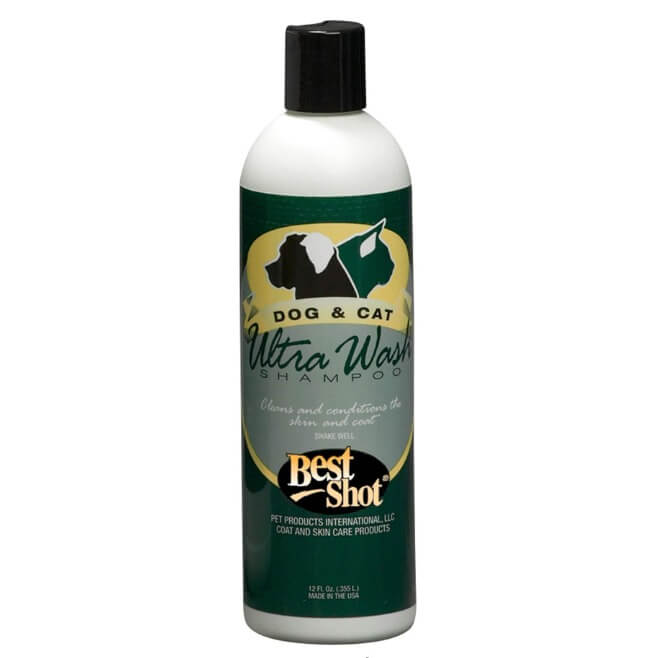
Shampoo & Conditioner In One: Earthbath 2-In-1 Conditioning Shampoo

Find the Best Deal:
Products To Use For Bathing Your Labradoodle: The Complete Grooming And Bathing Kit
Of course, you’ll only get good results when using the right products and grooming tools. For bathing your Labradoodle, you’ll need the following products:
- Dog brush and comb
- Dog detangler spray – this will speed up your brushing process before bathing!
- Towel – you can opt for either a special super absorbent dog towel or opt for your own towels.
- Dog shampoo and conditioner
- Nail clippers or a dog nail grinder
- Dog hair dryer
- Dog ear cleaner to prevent ear infections
- Optional: dog bath tub – super helpful to prevent any back pains!
- Optional: dog bathing brush – this product will help you lather up all that shampoo and get a good deep clean all throughout the coat.
In addition to that, if you’re also thinking about taking the whole hair trimming situation into your own hands, you need dog clippers, dog scissors, and thinning shears. And if you’re prone to back pain, a dog grooming table will be an absolute necessity.
Tips For Grooming Your Labradoodle At Home
A lot goes into grooming a Labradoodle (or any Doodle for that matter), and it can be hard to keep track of everything. Here’s a helpful checklist for you to keep your pooch looking fabulous at all times:
- Brushing: We recommend daily brushing to prevent matting, especially for curly-coated Labradoodles.
- Hair trimming: Labradoodles also need regular haircuts, about every 6 to 8 weeks, to keep their hair healthy and prevent any dullness. If you’d like to groom your Labradoodle at home, then this guide will help you get started. For more in-depth knowledge, we recommend you get our online course on How To Groom A Doodle At Home. And for hairstyle inspo, be sure to check out this guide.
- Ear hair trimming: Ear hairs should also be trimmed every 6 to 8 weeks.
- Ear cleaning: After each swim and bathtime, you should thoroughly dry your Labradoodle’s ears to prevent any overgrowth of bacteria. We also recommend you use a dog ear cleaner about once a week to prevent ear infections.
- Nail clipping: About once or twice a week, trim your Dood’s nails with a dog nail trimmer or nail grinder. This will prevent overgrown nails, discomfort, pain, and accidental injuries. Our ultimate guide on How To Trim Dog Nails has all the answers you need.
- Eye gunk: Lastly, we recommend you gently remove any eye gunk daily or more frequently, as this will help prevent discoloration around the eyes (and bad smells, too).
While there are quite a few steps in a Labradoodle’s grooming routine, once you get a hang of it, it won’t even take up that much of your time!
How Should I Get My Labradoodle Used To Bathing?
Although it may seem like all fun and games at first, bathing a Labradoodle (or any dog for that matter), might not go as smoothly for all pups. Here are some steps to getting your Labradoodle used to bathing:
- Start slow: Introduce your Labradoodle to the bathroom and the bathtub slowly. Let them sniff around and get comfortable with their surroundings.
- Use treats: Give your pup plenty of treats and praise during their first few bathing experiences to help them associate the experience with positive feelings.
- Use warm water: Make sure the water is warm and not too hot or cold. This will ensure your dog is comfortable and relaxed during the bath.
- Use a gentle touch: Use gentle movements and a calm demeanor when washing your Labradoodle. Speak in a reassuring tone to help keep them calm and relaxed.
- Be patient: It may take a few tries to get your Labradoodle used to bathing, so be patient and persistent. As they become more comfortable with the experience, they may even begin to enjoy bath-time!
Remember, every dog is different, and some may take longer to get used to bathing than others. If your Labradoodle seems especially nervous or anxious despite your best efforts, consider seeking advice from a professional dog trainer or behaviorist. For instance, in some cases, using a dog grooming muzzle can be a helpful aid.
Is It Safe To Use A Hairdryer To Dry Labradoodles’ Coat?
Yes, it is safe to use a hairdryer to dry a Labradoodle’s coat, as long as you use a low heat setting and keep the dryer at a safe distance from their skin. Always make sure your pup is comfortable and not stressed by the noise or force of the dryer. It may be helpful to start the dryer on a low setting and gradually increase the speed and heat to minimize any discomfort. You can also use a towel to help absorb excess water before using the dryer to avoid prolonged exposure. As with any grooming practice, it’s essential to ensure your pup’s safety and comfort throughout the process.
How Often Should I Bathe My Labradoodle: FAQs
Labradoodles in general tend to enjoy bathtime. However, the trick here is to get your pup used to bathing from an early age and with positive reinforcement. You should never force your dog when bathing them, nor should you yell at them for not being comfortable with the process!
You should brush your Labradoodle both before AND after bathing them to prevent matting.
First, you’ll let your Labradoodle shake off any water themself. Then, gently squeeze out the excess water with your hands from the areas where the fur is longer. Next, you’ll want to pat your Labradoodle dry with a towel or two. And once your dog is towel-dried, blow dry their hair with a dog blow dryer to get it all completely dry.
Before you start, place cotton balls into your Labradoodle’s ears to prevent any water getting inside. Thoroughly wet the fur while covering their eyes and nose so as to not get any water directly into them. Then you’ll gently apply the shampoo, carefully lather it up, and rinse it out. And you’re done!
Some dog owners prefer to bathe their Labradoodles weekly to prevent bad body odor, especially if their pups love to play outdoors. Although this can certainly work for some Labradoodles, for others it might cause issues with their skin and coat health. If you brush your Labradoodle daily, weekly bathing is likely not going to be necessary.
How Often Should I Bathe My Labradoodle: Final Thoughts
Bathing your Labradoodle is an important part of their grooming routine, but it’s essential to get the frequency right. We hope this article has answered your question “how often should i bathe my labradoodle?” and guide you on what steps need to be taken for proper bathing. Remember that every dog is different, so if your pup seems anxious during bath-time or needs extra care when drying off, don’t hesitate to reach out for professional help.
Want to Learn
DIY Doodle Grooming?
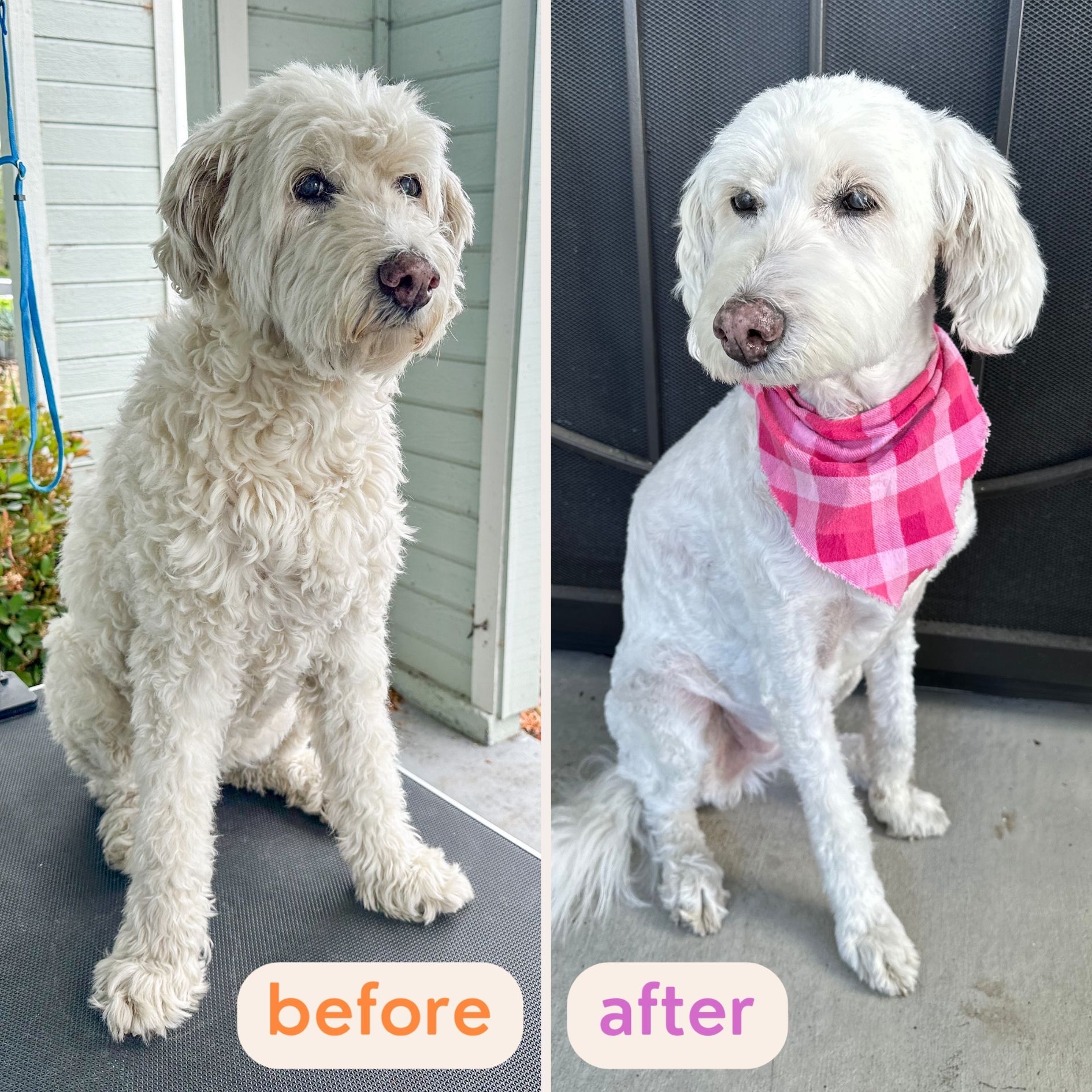
 “Every concern and question I had now has clear, practical solutions.” – Paula D.
“Every concern and question I had now has clear, practical solutions.” – Paula D.
 “These lessons have provided tremendous amounts of information.” – Steve B.
“These lessons have provided tremendous amounts of information.” – Steve B.
 “Buy the course and complain about how easy it is!” – Chris S.
“Buy the course and complain about how easy it is!” – Chris S.
Learn How To Groom Your Doodle At Home…
Safely…And Without Confusion:

